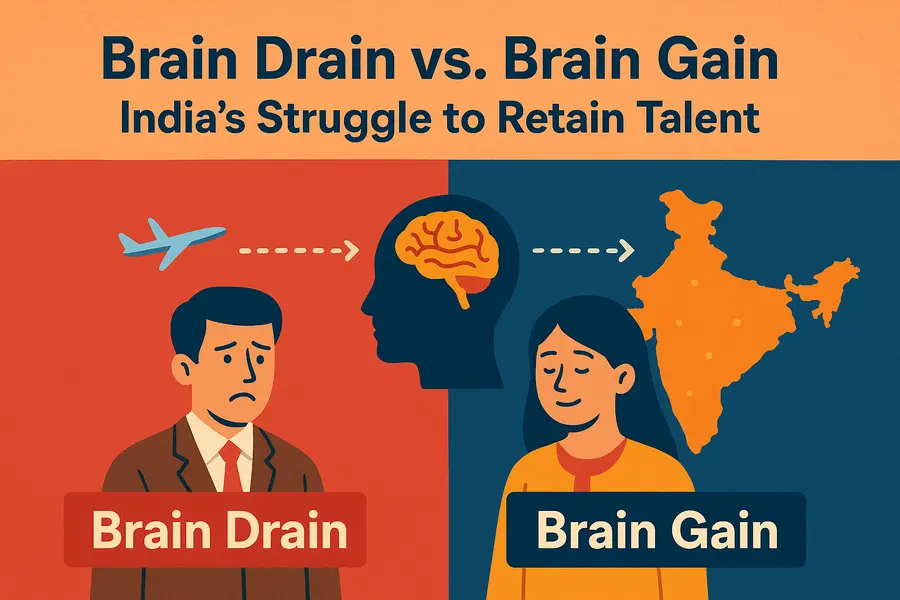Imagine a young engineer from Bihar who cracks IIT, then heads to Silicon Valley—never to return. Multiply that story by thousands, and you get a glimpse of India’s brain drain dilemma. But the story doesn’t end there. Some are coming back, bringing global experience and fresh ideas. This tug-of-war between brain drain and brain gain shapes India’s future.
Why do our brightest minds leave? What makes them return? And how can India turn this challenge into an opportunity?
In this article, we’ll explore the real reasons behind talent migration, its impact on the economy, and what India must do to retain and reclaim its intellectual capital.
Let’s dive into the struggle—and the hope—behind India’s talent journey.

Brain Drain vs. Brain Gain: India’s Struggle to Retain Talent
India faces a growing challenge as skilled professionals, students, and entrepreneurs migrate abroad for better opportunities. While brain drain weakens domestic innovation and workforce strength, emerging trends in reverse migration and global collaboration offer hope. To shift from brain drain to brain gain, India must improve education, research funding, and startup ecosystems—making talent retention a national priority.
Introduction: The Great Talent Tug-of-War
India is facing a great talent tug-of-war — a struggle between brain drain and brain gain.
Brain drain happens when skilled professionals move abroad for better jobs, education, or living conditions. On the other hand, brain gain is when those same experts return home or contribute knowledge and investments back to India.
For decades, India has been famous for “exporting brains” — from tech leaders in Silicon Valley to scientists and doctors around the world.
More than 17 million Indians live and work overseas, making India one of the largest sources of skilled migrants globally. Recent data indicates over 17.5 million to 18.5 million Indians living abroad. India is indeed a major source of skilled migrants, driven by a large pool of STEM graduates and a significant younger population
Now, the challenge isn’t just losing talent — it’s also about attracting it back. As India’s economy grows and opportunities expand in research, startups, and innovation, the question arises: Can India turn this ongoing brain drain into a true brain gain, building a stronger and smarter future in the global knowledge economy?
Historical Background: From Colonial Exodus to Global Workforce
To understand India’s brain drain story, we need to look back at how it all began. The migration of skilled Indians didn’t happen overnight — it evolved through different phases, shaped by history, economy, and opportunity.
In the post-independence years (1950s–1970s), India’s brightest minds — especially doctors, engineers, and academics — began moving abroad.
With limited research infrastructure and lower pay scales at home, countries like the United States and the United Kingdom became attractive destinations. This was the first major wave of academic and medical migration, marking the early roots of India’s brain drain.
Then came the IT revolution of the 1990s, and India emerged as a global technology hub. As software services boomed, so did the export of Indian talent to Silicon Valley, Europe, and the Middle East.
Indian engineers became the backbone of the global tech industry, and India was soon labeled a “brain exporter.”
The 2000s globalization era brought another remarkable shift. Indians who had once left began to lead — many rose to top positions in global corporations. Think of Sundar Pichai at Google, Satya Nadella at Microsoft, or Arvind Krishna at IBM. These success stories changed global perceptions of Indian professionals, turning them into symbols of innovation and leadership.
Today, India’s migration story is no longer just about escaping limited opportunities — it’s about building a network of global influence.
The Indian diaspora, spread across continents, contributes to both India’s soft power and its economy through knowledge sharing, investments, and global collaborations.
From colonial exodus to a powerful global workforce, India’s journey reflects not just migration trends — but the country’s growing importance in shaping the world’s future.
Understanding the Brain Drain Phenomenon
To truly understand brain drain, we first need to know what it means. In simple terms, brain drain happens when talented and educated people leave their home country to live, study, or work abroad — often in search of better opportunities. This movement of skilled individuals takes different forms: educational brain drain (students going abroad for higher studies), professional brain drain (working professionals moving for jobs), and entrepreneurial brain drain (business minds setting up ventures overseas).
Educational Brain Drain
Indian students pursue higher education abroad, often staying permanently due to better academic infrastructure, research opportunities, and career prospects. This leads to a loss of future scholars and innovators, weakening India’s intellectual capital and reducing returns on public investment in early education.
Professional Brain Drain
Skilled professionals—doctors, engineers, scientists—migrate for higher salaries, better work conditions, and career growth. India loses critical talent in healthcare, technology, and research, causing shortages and slowing innovation. Bureaucratic hurdles and limited opportunities at home accelerate this outflow.
Entrepreneurial Brain Drain
Startup founders and business minds relocate to countries with easier access to funding, fewer regulations, and global markets. India misses out on job creation, innovation, and economic dynamism. The domestic startup ecosystem suffers as high-potential ventures scale abroad instead of locally.
What Causes Brain Drain in India?
India has been experiencing all three. One major reason is the lack of research funding and advanced infrastructure.
Many young scientists and researchers head to countries like the U.S. or Germany where laboratories and grants are far more accessible.
Low wages and a limited culture of innovation at home further push skilled professionals to look elsewhere.
Add to that the bureaucratic red tape and occasional political instability, and it’s easy to see why some feel their potential might be better recognized abroad.
For many, the appeal also lies in a better quality of life, stronger work environments, and global exposure.
According to recent data from the Ministry of External Affairs, more than 1.3 million Indian students are currently studying abroad.
The World Bank and OECD also note that India is among the top countries contributing to global skilled migration, with over 32 million NRIs (Non-Resident Indians) living across the world.
Experts suggest that while migration brings global experience, it also means a loss of domestic innovation and slower research growth.
However, many of these professionals still contribute back through remittances, mentorship, and collaborations — showing that brain drain isn’t always a total loss, but a complex part of India’s evolving talent story.
The Flip Side: Brain Gain and Reverse Migration
While brain drain has long been a concern, India is now witnessing the other side of the story — brain gain and reverse brain drain.
Brain gain happens when skilled Indians return home or contribute knowledge and investment back to India. Reverse brain drain refers to those professionals who, after years of working abroad, come back to build careers, startups, or research projects in their home country.
So, what’s attracting them back? For starters, India’s startup boom and digital revolution have created massive opportunities. Cities like Bengaluru, Hyderabad, and Pune are now buzzing with innovation, drawing back tech experts and entrepreneurs who once worked in Silicon Valley.
The government, too, is playing a big role. Initiatives such as Startup India, Make in India, and GIAN (Global Initiative of Academic Networks) encourage returning professionals to share their global expertise and help boost India’s innovation ecosystem. These schemes make it easier to start businesses, collaborate with research institutes, and access funding.
Besides, improved salaries, international exposure, and growing respect for research and entrepreneurship are making India more attractive. And for many, it’s not just economics — it’s emotional. The pull of home, family, and a sense of belonging often inspire professionals to return and make a difference.
There are several success stories — from scientists returning to lead advanced research labs to tech entrepreneurs who built startups after years abroad. Their return is transforming India’s image from a talent exporter to a global innovation hub.
India’s story is no longer just about losing talent — it’s also about winning it back, and turning that return into a powerful advantage for the country’s future.
Impact of Brain Drain on India’s Economy and Innovation
The impact of brain drain on India’s economy and innovation is a story with both challenges and opportunities. On the surface, losing skilled professionals to other countries may seem like a setback — a short-term loss of talent that could have driven India’s growth from within. But look closer, and you’ll see a more complex, evolving picture.
While many talented Indians move abroad, they often build valuable global networks that later benefit India through knowledge sharing, investments, and collaborations. The money sent back home — known as remittances — also plays a huge role.
In fact, India consistently ranks among the world’s top remittance-receiving countries, which supports millions of families and fuels domestic spending.
A newer concept, called “brain circulation,” is now replacing the old idea of one-way migration. Instead of permanently losing talent, India is seeing more professionals move back and forth — studying or working abroad, then returning home to apply what they’ve learned. This global exposure sparks creativity and fuels innovation in India’s startups, research labs, and digital economy.
Returnees often become key players in startups, R&D, academia, and technology transformation.
Many success stories reflect this trend — take the founders of Flipkart, Zoho, and Ola, for example. They studied or worked abroad but came back to create groundbreaking ventures that reshaped India’s economy.
So, while brain drain does create gaps in the short term, it’s also planting seeds for a smarter, more connected India. By turning migration into collaboration, the country is gradually transforming its global diaspora into a powerful engine of progress and innovation.
Policy Perspective: What India Is Doing (and Needs to Do)
India has recognized that keeping its best minds at home — or bringing them back — requires strong and smart policies. Over the years, the government has launched several initiatives to reduce brain drain and promote talent retention.
Programs like VAJRA (Visiting Advanced Joint Research Faculty Scheme) invite top Indian-origin scientists from abroad to collaborate with local institutions.
Similarly, RUSA (Rashtriya Uchchatar Shiksha Abhiyan) focuses on improving the quality of higher education through better funding and infrastructure.
The Prime Minister’s Fellowship for Doctoral Research encourages young researchers to stay in India by offering financial support and industry linkages.
The National Education Policy (NEP) 2020 has also opened doors for international collaborations, flexible learning, and global partnerships — steps aimed at making Indian universities more competitive and globally relevant.
However, there are still policy gaps to bridge. Experts point out the need for greater research autonomy, world-class laboratories, and competitive pay scales that match international standards.
India must also strengthen academia–industry partnerships so that research ideas can turn into real-world innovations and startups.
Looking abroad offers valuable lessons. China successfully brought back millions of scholars through incentives and strong R&D funding. South Korea and Israel focused on building robust innovation ecosystems that made returning home attractive for their citizens.
For India, the goal is clear: create an environment where innovation thrives, bureaucracy is minimal, and global Indian talent sees a future here.
With the right mix of policy, funding, and collaboration, India can shift from losing talent to leading global knowledge creation.
The Way Forward: Turning Brain Drain into Brain Circulation
The time has come for India to move beyond the old idea of brain drain and embrace a new vision — brain circulation. Instead of viewing migration as a loss, India can turn it into an opportunity for knowledge exchange, where talent flows freely across borders, bringing back ideas, skills, and investments.
The key lies in building strong global Indian networks. Millions of professionals, researchers, and entrepreneurs of Indian origin are spread across the world. By connecting them with institutions and startups back home, India can create a powerful ecosystem of collaboration — one that drives innovation and global partnerships.
To make this happen, India needs to invest in education reform and innovation infrastructure. More research funding, world-class universities, and startup-friendly policies can motivate talented youth to stay or return. At the same time, engaging the Indian diaspora through dedicated programs and digital platforms can help channel their expertise into national growth.
India’s young population is its biggest advantage. With the rise of Digital India, artificial intelligence, and emerging technologies, the country has the potential to lead the next wave of the global knowledge economy. Empowering the youth with skills and opportunities will be key to turning ambition into action.
The future isn’t about stopping people from leaving — it’s about staying connected, collaborating, and creating value together. If India can turn this brain circulation into a continuous exchange of talent and ideas, it will not only retain its best minds but also attract global ones.
The vision is clear: to transform India into a vibrant global knowledge hub that thrives on innovation, inclusion, and shared success.
Conclusion: Reimagining India’s Talent Equation
India’s real challenge isn’t just to retain its talent, but to create value through global connectivity.
The world today thrives on collaboration, not isolation. Every Indian scientist, engineer, or entrepreneur abroad represents a bridge — a chance to connect ideas, innovation, and investment back home.
Instead of fearing brain drain, India must focus on transforming it into brain gain through stronger networks, better opportunities, and inclusive growth.
As former President A.P.J. Abdul Kalam once said, “Dream, dream, dream — dreams transform into thoughts and thoughts result in action.” That action today must come from policymakers, institutions, and individuals working together to nurture creativity, strengthen education, and encourage collaboration across borders.
If India succeeds in doing so, it can truly become a global knowledge hub, powered not just by talent, but by trust, technology, and teamwork — proving that when brains circulate, nations rise.





